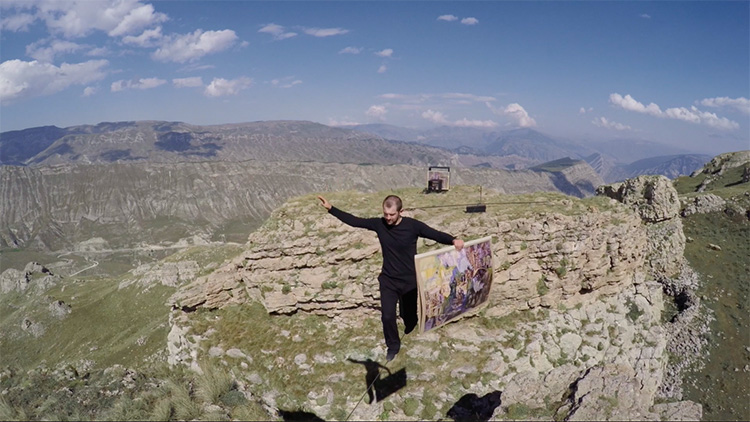Taus Makhacheva
Tightrope
15 February - 14 October 2018
Video, 58:10 mins.
Taus Makhacheva's video piece, Tightrope, takes place in the breathtakingly beautiful, mountainous landscape of Dagestan, in a state between tension and meditation. Rasul Abakarov is a fifth generation member of a family of tightrope walkers. In the video, he wanders from one rocky hilltop to the other, carrying copies of artworks from the Dagestan Museum of Fine Arts. Makhacheva's video works inspire reflection on what a museum truly is, on art, heritage and our contemporary age.
The artist Taus Makhacheva (b.1983) twists perspectives, with the viewer or the self becoming small in relation to the mountain ridges, the endless expanses and the large movements of air. As belonging to the ethnic group Avars, and living part time in Makhachkala, Dagestan, Taus Makhacheva is interested in how the landscape is both a home, a place for recuperation, and a scene for historical narratives. In the video, Makhacheva often makes use of performative acts that refer to painting or photography. She has regularly collaborated with dancers, and here we meet the tightrope walker Rasul Abakarov, who transports art in a predetermined pattern with considerable risk for his own life.
Taus Makhacheva has a close relationship with the art at the state-run, P. S. Gamzatova Dagestan Museum of Fine Arts. The museum has been named after its first director, Patimat Saidovna Gamzatova, who is also Makhacheva's grandmother, and the one who formed the collection. Among the works is a painting of her grandfather, the poet Rasul Gamzatova, paying a social call to Fidel Castro portrayed by the artist Yusuf Mollaev. The motif suggests the precarious balancing act that the Dagestani people have always undertaken between the pursuit of sovereignty and subservience to the communist party agenda. During the communist era, a system was in place where provincial museums exchanged art with each other, so that all citizens could, over time, gain access to the same art. Besides painting and print art from Western Europe and Dagestan, P. S. Gamzatova has a large collection of arts and crafts and applied art such as silverware, carpets, and wood carvings. Makhacheva is interested in what happens to an artwork when it is incorporated into a collection, how details fall into oblivion and new meanings emerge as the collection changes.
Rasul Abakarov's transportation of art can be seen as quite a vain practice. Why risk everything for art, for a collection? When Immanuel Kant formulated himself with regard to the freedom of art, it was specifically the uninterested gaze that created art's specific role. The video, Tightrope, is a poetic representation of art's worth, but also of the smallness of our civilization in comparison to the formation of a mountain.
Rebecka Wigh Abrahamsson, curator Uppsala Art Museum

